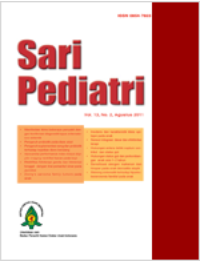Hubungan antara Patogen Usus dengan Kadar Laktoferin Tinja pada Anak dengan Diare Akut
Sari
Latar belakang. Para dokter sering mengalami kesulitan membedakan diare akut yang disebabkan oleh bakteri maupun non-bakteri.
Kadar laktoferin (LF) tinja merupakan petanda migrasi neutrofil dalam lumen usus dan dihubungkan dengan inflamasi usus.
Tujuan. Mengetahui hubungan antara patogen usus dengan kadar LF tinja pada anak dengan diare akut
Metode. Penelitian analitik observasional dengan pendekatan potong lintang dilakukan di dua rumah sakit umum kota Manado selama
bulan Juli hingga November 2013. Pengambilan sampel dilakukan secara konsekutif pada anak berusia 7-60 bulan yang menderita
diare akut. Hasil dianalisis secara deskriptif untuk data karakteristik anak dan data laboratorium, serta analisis regresi dan korelasi
linier sederhana. Data diolah menggunakan program SPSS versi 21, dengan tingkat kemaknaan p<0,05.
Hasil. Total sampel yang didapatkan 43 pasien diare akut, terdiri atas 25 laki-laki dan 18 perempuan. Kadar LF tinja yang disebabkan
oleh patogen usus bakteri didapatkan rerata 9,65 (SB 3,69) μg/g. Sementara kadar LF tinja yang disebabkan oleh patogen usus non
bakteri didapatkan rerata 3,72 (SB 1,48) μg/g. Terdapat perbedaan bermakna rerata LF tinja pada kedua kelompok patogen usus
(p<0,001, r=0,591).
Kesimpulan. Adanya hubungan yang bermakna antara patogen usus dengan kadar laktoferin tinja pada anak dengan diare akut.
Patogen usus golongan bakteri memiliki kadar laktoferin tinja yang lebih tinggi daripada patogen usus golongan non bakteri.
Kata Kunci
Teks Lengkap:
PDFReferensi
Al-Gallas N, Bahri O, Bouratbeen A, Haasen AB, Aissa
RB. Etiology of acute diarrhea in children and adults
in Tunis, Tunisia, with emphasis on diarrheagenic
Escherichia coli: prevalence, phenotyping, and molecular
epidemiology. J Trop Med Hyg 2007;77:571-82.
Podewils LJ, Mintz ED, Nataro JP, Parashar UD. Acute,
infectious diarrhea among children in developing
countries. J Spid 2004;05:155-65.
Gill CJ, Lau J, Gorbach SL, Hamer DH. Diagnostic
accuracy of stool assays for inflammatory bacterial
gastroenteritis in developed and resource-poor countries.
CID 2003;37:365-75.
Santos DRD, Silva LR, Silva N. Antibiotics for the
empirical treatment of acute infectious diarrhea in
children. BJID 2006;10:217-27.
Marcus N, Mor M, Amir L, Mimouni M, Waisman Y.
The quick-read C-reactive protein test for prediction
of bacterial gastroenteritis in the pediatric emergency
department. Pediatr Emerg Care 2007;23:634-7.
Guerrant RL, Araujo V, Soares E, Kotloff K, Lima AAM, Cooper WH, dkk. Measurement of fecal lactoferrin
as a marker of fecal leukocytes. J Clin Microbiol
;30:1238-42.
Gadewar S, Fasano A. Current concepts in the evaluation,
diagnosis and management of acute infectious diarrhea.
Curr Opin Pharmacol 2005;5:559-65.
D’Inca R, Dal Pont E, Di Leo V, Ferronato, Fries W,
Vettorato MG, dkk. Calprotectin and lactoferrin in
the assessment of intestinal inflammation and organic
disease. Int J Colorectal Dis 2007;22:429-37.
Chen CC, Chang CJ, Lin TY, Lai MW, Chao HC, Kong
MS. Usefulness of fecal lactoferrin in predicting and
monitoring the clinical severity of infectious diarrhea.
WJG 2011;17:4218-24.
Savola KL, Baron EJ, Tompkins LS, Passaro DJ. Fecal
leukocyte stain has diagnostic value for outpatients but
not inpatients. J Clin Microbiol 2001;39:266-9.
.Granville LA, Cernoch P, Land GA, Davis JR.
Performance assessment of the fecal leukocyte test for
in patients. J Clin Microbiol 2004;42:1254-6.
Stoll BJ, Glass RI, Banu H, Hug MI, Khan MU, Ahmed
M. Value of stool examination in patients with diarrhoea.
Br Med J 1983;286:2037-40.
Tormo R, Polanco I, Lindo ES, Goulet O. Acute
infectious diarrhoea in children: new insights in
antisecretory treatment with racecadotril. Acta Paediatr
;97:1008-15.
Lung E. Acute Diarrheal disease. Dalam: Friedman SL,
McQuaid KR, Grendell JH, editors. Current diagnosis
and treatment in gastroenterology. Edisi ke-2. New York:
Lange Medical Books; 2003.h.131-50.
Vermoir S, Van Ascsche G, Rutgeerts P. Laboratory
markers in IBD: useful, magic, or unnecessary toys? Gut
;55:426-31.
Foel D, Wittkowski H, Roth J. Monitoring disease
activity by stool analyses: from occult blood to molecular
markers of intestinal inflammation and damage. Gut
;58:859-68.
Choi SW, Park CH, Silva TM, Zaenker EI, Guerrant RL.
To culture or not to culture: fecal lactoferrin screening
for inflammatory bacterial diarrhea. J Clin Microbiol
;34:928-32.
Venkataraman S, Ramakhrisna BS, Kang G, Rajan DP,
Mathan VI. Faecal lactoferrin as a predictor of positive
faecal culture in south Indian children with acute
diarrhoea. Ann Trop Paediatr 2003;23:9-13.
Levay PF, Viljoen M. Lactoferrin: a general review.
Haematologica 1995;80:252-67.
Hayakawa T, Jin CX, KO SBH, Kitagawa M, Ishiguro
H. Lactoferrin in gastrointestinal disease. Inter Med
;48:1251-4
Langhorst J, Elsenbruch S, Koelzer J, Rueffer A.
Michalsen A, Dobos GJ. Noninvansive markers in the
assessment of intestinal inflammation bowel disease:
performance of fecal lactoferrin, calprotectin, and PMNelastase,
CRP, and clinical indices. Am J Gastroenterol
;103:162-9.
Kane SV, Sandborn WJ, Rufo PA, Zholudev A, Boone J,
Lyerly D, dkk. Fecal lactoferrin is a sensitive and specific
marker in identifying intestinal inflammation. Am J
Gastroenterol 2003;98:1309-14.
Mercado EH, OchoaTJ, Ecker L, Cabello M, Durand D,
Barletta F, dkk. Fecal leukocytes in children infected with
diarrheagenic Escherichia coli. JCM 2011;4:1376-81.
Chin AC, Parkos CA. Pathobiology of neutrophil
transepithelial migration: implications in mediating
epithelial injury. Annu Rev Pathol Mech Dis 2007;2:111-
DOI: http://dx.doi.org/10.14238/sp17.2.2015.124-8
Refbacks
- Saat ini tidak ada refbacks.
##submission.copyrightStatement##
##submission.license.cc.by-nc-sa4.footer##
Email: editorial [at] saripediatri.org


Sari Pediatri diterbitkan oleh Badan Penerbit Ikatan Dokter Anak Indonesia
Ciptaan disebarluaskan di bawah Lisensi Creative Commons Atribusi-NonKomersial-BerbagiSerupa 4.0 Internasional.




